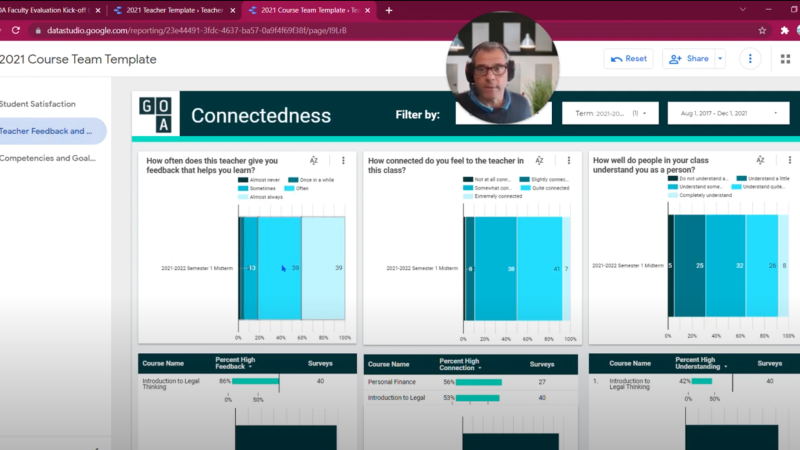Educator Competencies: Shifting Teacher Practice
How do we support teachers in shifting their practice in order to support a competency-based approach to education? GOA’s approach to this question has been to articulate a set of Educator Competencies to serve as a north star for teacher practice. Announced in September 2021, these educator competencies were designed as a way to build capacity, support teacher self-efficacy, and ultimately improve student learning outcomes.
A year after finalizing and publishing these educator competencies, we’ve been using them to make moves that matter. At the 2022 Mastery Transcript Consortium Symposium in San Diego, CA, GOA facilitated a partner breakout session called “Educator Competencies: Shifting Teacher Practice.” In the workshop, we shared some of our insights about how to make educator competencies a lived reality in our schools.
In this post, we’ll recap aspects of that workshop: why do educators competencies matter and how can educator competencies be used to support shifts in teaching and learning?
Why do educator competencies matter?
Educator competencies are an articulated set of skills that seek to answer the question, “What do educators need to know and be able to do?” Much in the same way that a Portrait of a Graduate or a set of student competencies serve to articulate, “what does it mean to be a graduate of this school?”, educator competencies serve to clearly name and make visible what good teaching looks like.
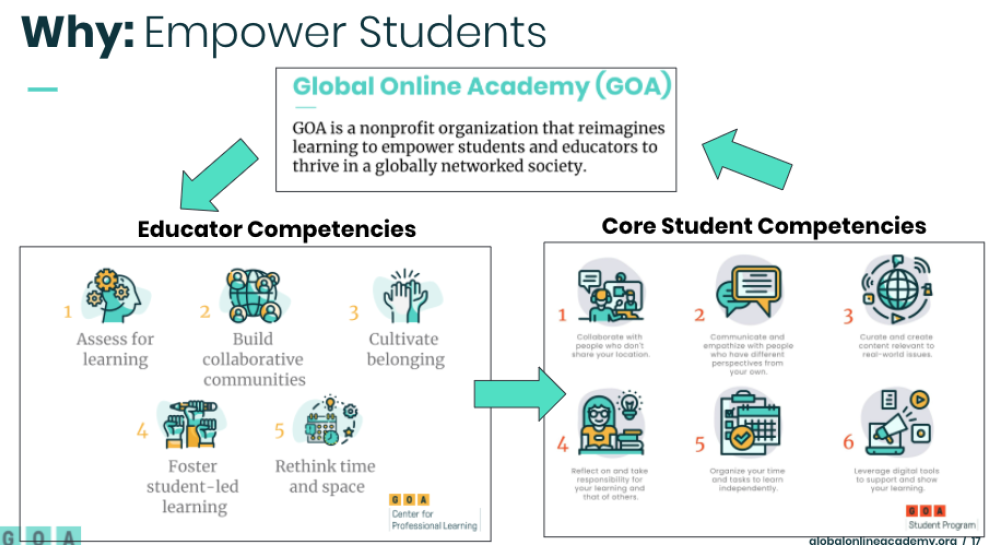
The importance of having a set of educator competencies cannot be understated. Educator competencies play a vital role in providing clarity for teachers around what it looks like to actually further the mission of the school and how they can work towards designing experiences that support student competency. Creating a common language ensures that there’s alignment and consistency across a school’s programs.
At the same time that educator competencies create a framework and a sense of structure, they also afford the opportunity for flexibility within that structure. Educator competencies provide teachers with the opportunity for personalized pathways, a chance to really target the areas in which they want to grow. In this way, educator competencies allow for us to model with teachers the types of learning that they want to have with students.
How do we make educator competencies a lived reality?
Systems and Structures
At GOA, in order for our educator competencies to be the embodiment of how our teaching faculty execute our mission, we have worked hard to structure many aspects of our faculty experience around this framework. The best way, of course, to build a faculty with a certain skillset is to hire teachers who either already possess or are inclined toward those specific skills. From the very first time we meet teaching candidates, we are talking with them about our educator competencies (whether they know it or not). Below is a screenshot of a form that our interviewers use when talking with candidates. The form gives them a space to input notes about evidence they see in resumes and hear in interviews that a candidate possesses the necessary skills and dispositions to be successful with our educator competencies. The form also prompts interviewers with some questions they might use to better understand the candidates’ experiences and skillsets.
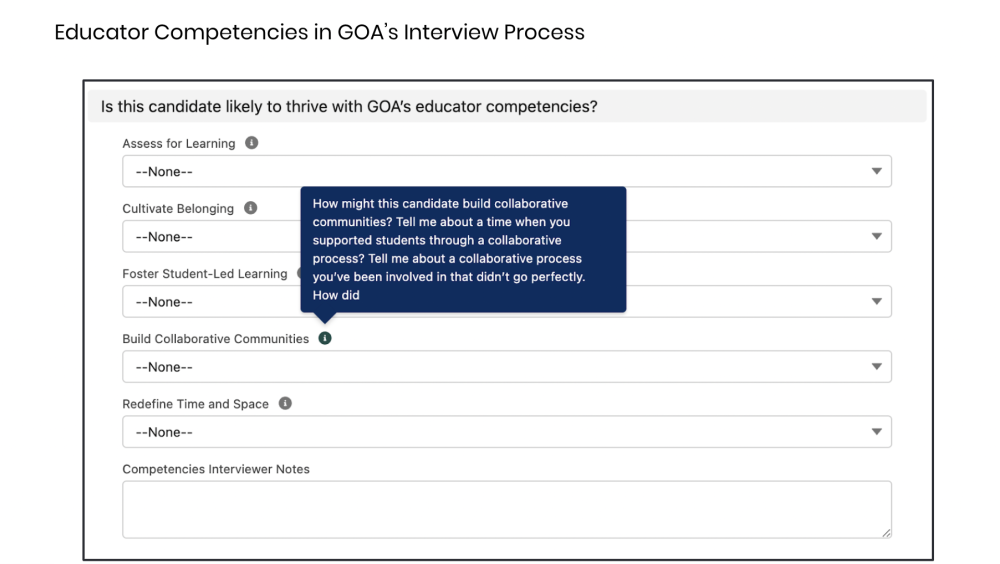
When teachers are hired, they immediately go into an asynchronous Canvas training where they encounter videos of veteran teachers discussing their work as it relates to the various educator competencies and then in July and August they participate in a three-day synchronous event (Faculty Camp!) during which all of the sessions use our educator competencies as an organizing mechanism.
Once the semester is underway, GOA students take a survey twice each term for which the questions are aligned with educator competencies. The screenshot below shows an anonymized admin-level view of results for the question “How often does this teacher give you feedback that helps you learn?”, which is aligned to our Assess for Learning competency. Teachers, instructional coaches and GOA staff engage in conversation around these survey results at various levels in order to facilitate personalized professional development for each teacher, as well as program-level shifts to grow teacher practice and improve the learner experience.
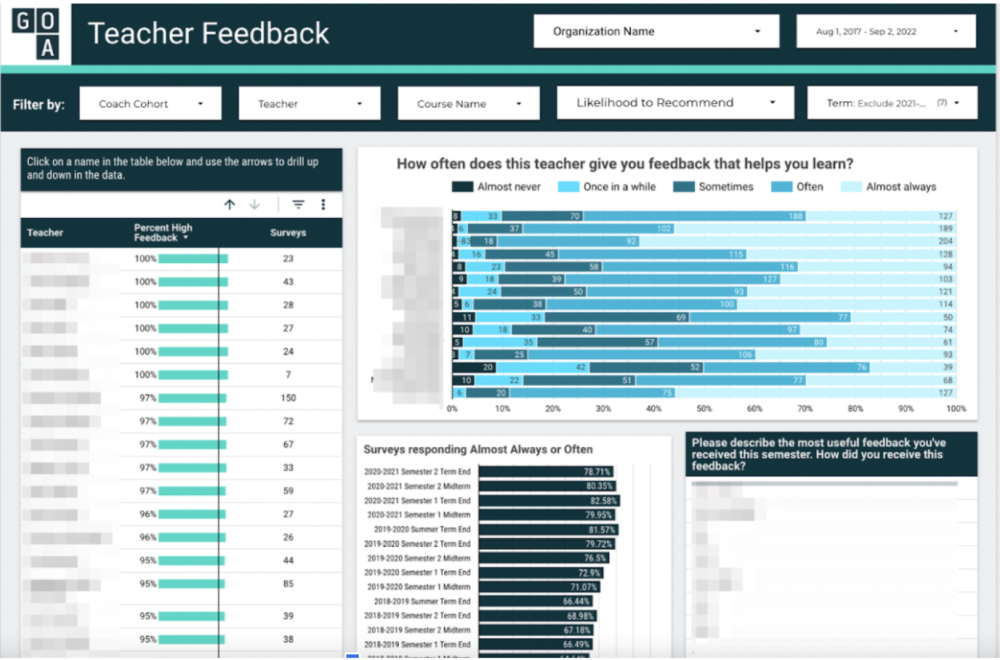
The survey results, however, are only a part of the teacher-coach conversations. At the end of each semester, GOA faculty complete a self assessment where they choose 2-3 educator competencies and reflect on where and how they are excelling and what steps forward they might take in future semesters. Coaches then recommend GOA PL courses that are, you guessed it, aligned to the same educator competencies.
Our formal Teacher Evaluation and Growth Process is built on the same foundations. Teachers complete the same self assessment - though when they’re on evaluation we ask that they address all of the educator competencies, and provide links to their work and their students’ work as evidence of mastery.
GOA Faculty Feedback Session
Blaine Harris
Then, the instructional coach and a GOA staff member review the self-assessment, the teachers’ survey results, the courses themselves and all of the various artifacts therein. The teacher, the instructional coach and the GOA Staff member then meet for an hour to celebrate the teachers’ growth and accomplishments and chart a path forward. The coach follows up with a competency-aligned written report that summarizes the conversation.
In short, we have been adamant that our educator competencies are not simply a communications framework or a website decoration. Rather, we’ve sought to frame every aspect of the GOA teachers’ experience around them for the sake of clarity, transparency and mission alignment
Professional Learning
It’s one thing to name competencies; teachers want to know what these skills actually look like in practice. GOA’s Center for Professional Learning (CPL) has spent time breaking down what these competencies look like in action by identifying core indicators and creating rubrics aligned to each of the five competencies. These rubrics serve as powerful tools for teacher self-assessment and goal-setting, as well as the basis for coaching conversations.

However, it’s not enough to just identify areas of growth; there needs to be a course of action following that reflection. A year out from unveiling the educator competencies, GOA’s CPL has been designing learning experiences aligned to the competencies that allow educators to grow in meaningful ways.
In creating our professional learning offerings, we are intentionally designing pathways for each educator competency as a way to build teacher agency by offering choice. Similar to how for students we start with competencies and design learning experiences to support students to grow in those competencies, we’re using the educator competencies and corresponding indicators as the blueprint for the educator experiences we’re designing.
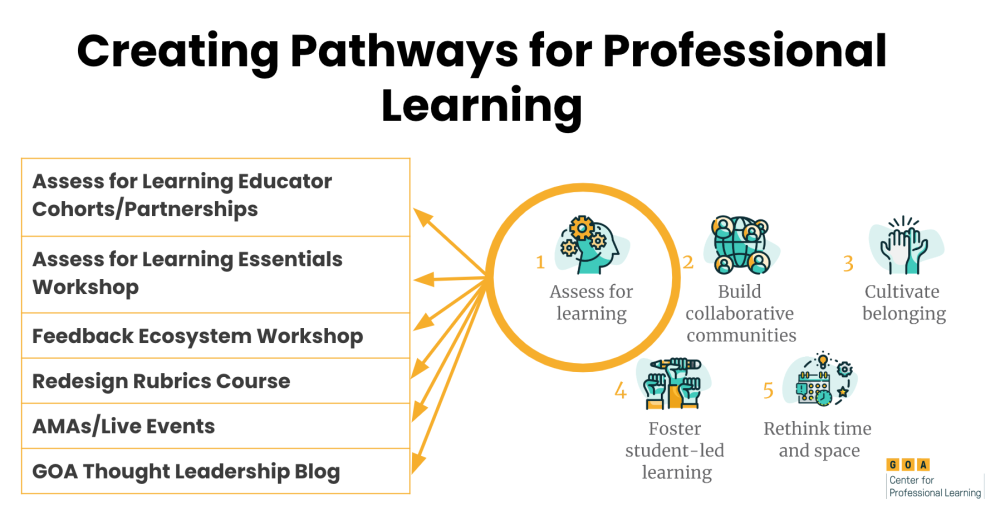
Whether it’s an educator course, a workshop, or a cohort, the educator competencies inform how we curate resources, design sprints, and facilitate conversations with educators. As stated in our 2022 Impact Report, “The result is that teachers walk away from our professional learning experiences with the knowledge and skills they need to move from theory to practice and have a measurable, meaningful impact on student learning.”
We work with educators and school leaders on initiatives that support meaningful learning experiences for students and adults. To learn more, explore our services and submit an inquiry.
For more, see:
- The Power of Collective Purpose in Schools
- Back-to-School Professional Learning: What Educators Need in 2022/2023
- Impact and Outcomes: Stories and Data from Our Work with Students, Educators, and Schools
GOA serves students, teachers, and leaders and is comprised of member schools from around the world, including independent, international, charter, and public schools. Learn more about Becoming a Member. Our professional learning opportunities are open to any educator or school team. Follow us on LinkedIn and Twitter. To stay up to date on GOA learning opportunities, sign up for our newsletter.




